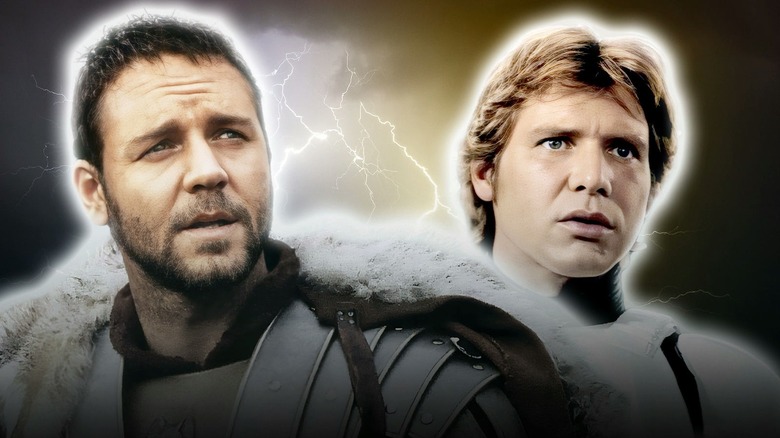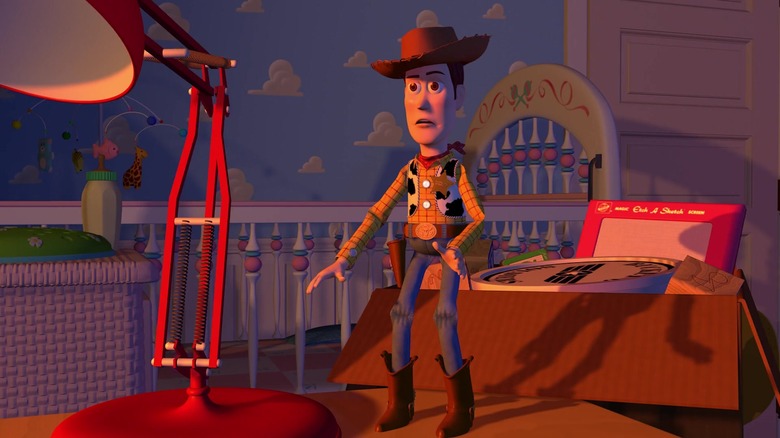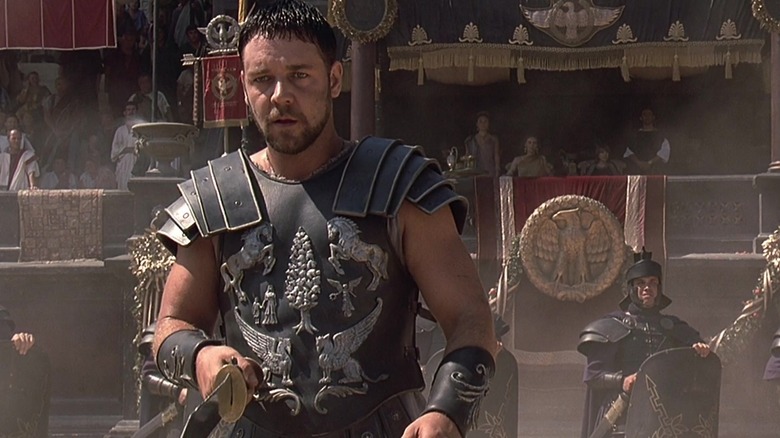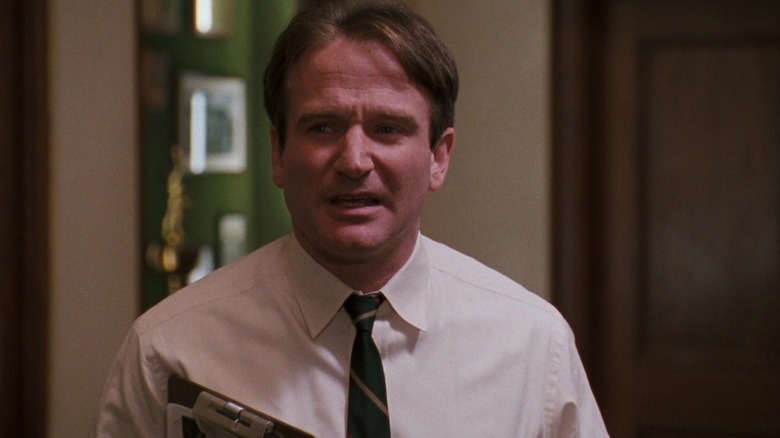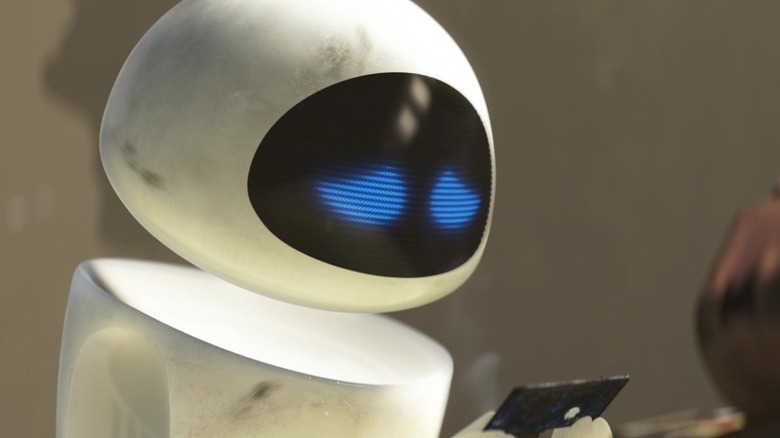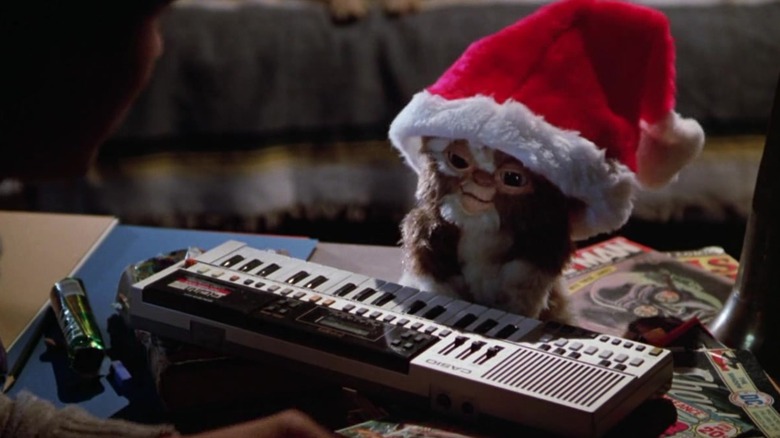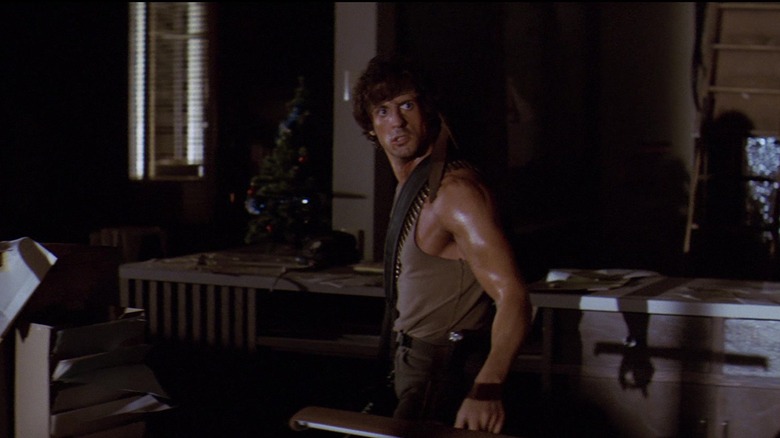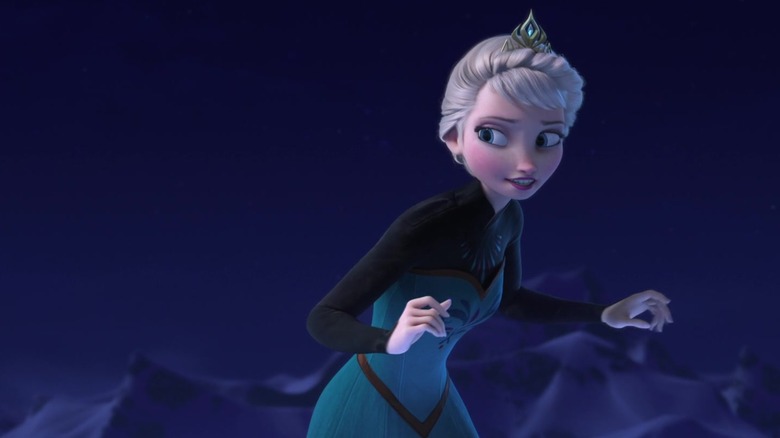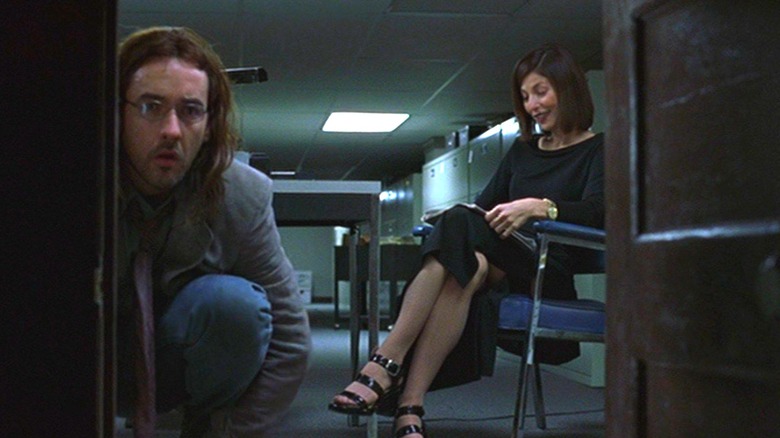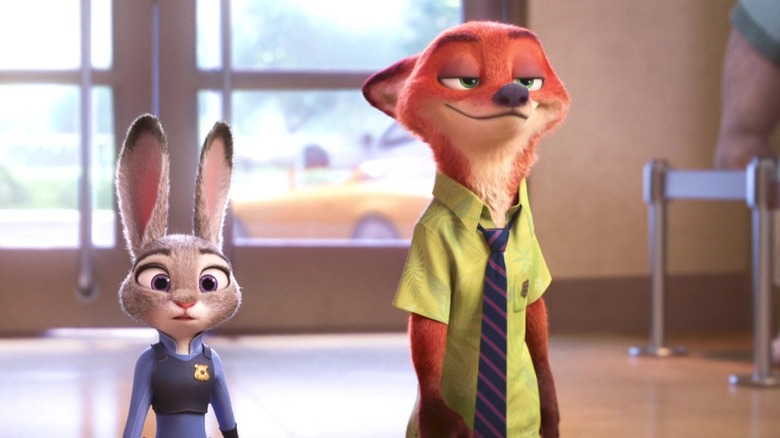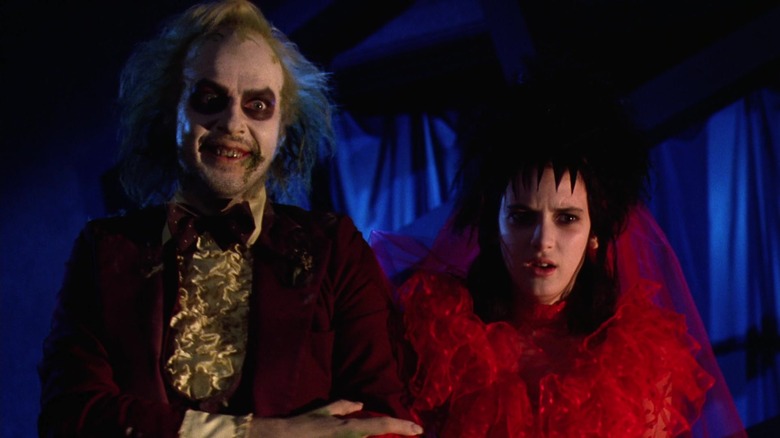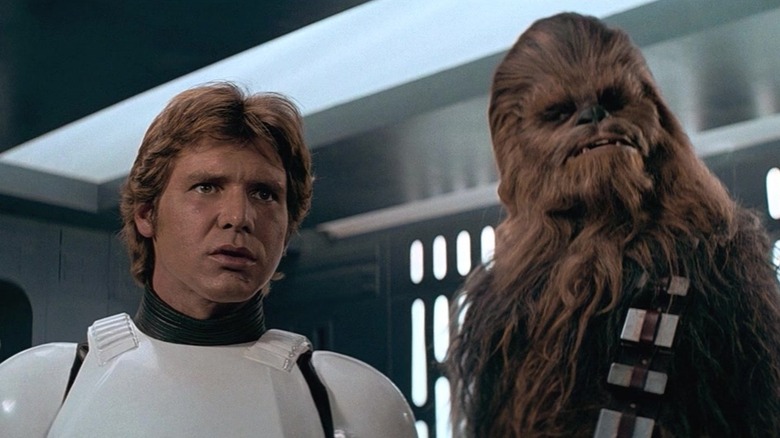Original Scripts That Would Have Ruined Great Movies
It is easy to assume that a great movie has always been a great movie, ever since the screenwriter first put a pen to the page or opened a document on their laptop. In reality, even the best movies have transformed between the original script to the final product, and more often than not, the first draft of a milestone was just as likely to be a hot mess as that of a cheapo B-movie. This is true even of films written by Oscar-winning screenwriters like Charlie Kaufman and talented filmmaking teams like the story artists at Pixar.
For instance, one beloved Pixar character wasn't nearly as endearing in his earliest form, while an iconic character from "Star Wars" originally had a very different look. You may also be surprised to learn the title we almost got for the movie "Beetlejuice." If any of these excellent films had stuck with their original scripts, they might have well been ruined and forgotten.
Below we have compiled the most outrageous early versions of classic movies, along with terrible first drafts of what would later become wonderful scripts — all of which we're lucky to have today.
Toy Story
If Pixar had gone with their original plans for "Toy Story," the film would have sunk the fledgling animation studio before it even got off the ground.
To put it simply, in previous drafts of the script, Woody (Tom Hanks) was a jerk. Instead of the cowboy doll we all know and love, the character was a creepy ventriloquist dummy who was cruel to the other toys. In this version Woody deliberately pushed Buzz (Tim Allen) out the window — unlike the final film, where it's an unintended consequence of Woody's actions. Woody even tormented Slinky Dog (Jim Varney). "The character of Woody was really abrasive and unlikeable in the way he was being presented," reflected animator Ralph Eggleston in an interview with The San Francisco Chronicle. "In the guise of attempting to make him hip and cool and edgy, it became kind of snide and cynical."
The lowest point for the "Toy Story" team was when they needed to present to a bunch of Disney executives; they chose to share a sequence where a tyrannical Woody whipped the other toys into submission. The Disney execs were appalled and threatened to shut down the project unless Pixar could write something better within two weeks. Luckily, Pixar pulled it off, reinventing Woody as a toy who just wanted to be loved (even if he could sometimes be a bit selfish). Thank goodness they did, because the world of CGI animation owes "Toy Story" a massive debt.
Gladiator
Initially, Russell Crowe was reluctant to sign onto "Gladiator" because when he first saw the script, he felt (per Variety) that "it was rubbish, absolute rubbish." In the first draft, Crowe's character was named Narcissus instead of Maximus. Technically, this name makes sense because it was the name of the real-life man who killed Emperor Commodus (Joaquin Phoenix). Still, "Narcissus" doesn't have quite the same ring to it. The hero's catchphrase would have been "Surrender, or I'll kill you!" which is a far cry from his motto of "Strength and honor" in the final film.
As well, in this version Narcissus would have courted sponsors who agreed to pay him money for endorsing their products in the second-century equivalent of advertisements, such as "Narcissus drinks only Golden Pompeii olive oil!" Most notably, the script contained a sequence in which Commodus burns the entire Senate alive inside a giant brass bull and then appoints several chimpanzees to replace them. If you thought the tigers from the final film were over-the-top, you can take consolation in knowing that at least this scene did not make the final cut.
According to Crowe, even the producer thought the script was terrible and begged Crowe not to read it, instead asking him to meet with director Ridley Scott. Crowe agreed to meet with Scott, and once the director expressed his true vision for the film, Crowe agreed to join the project. The rest is cinematic — if not exactly Roman — history.
Dead Poets Society
"Toy Story" and "Gladiator" aren't the only Oscar-nominated (and in this case, Oscar-winning) screenplays that had terrible first drafts. The original version of "Dead Poets Society" was in desperate need of a rewrite. The initial draft of the script gave English teacher Mr. Keating (Robin Williams) a secret reason to urge his students to "seize the day" — he had a terminal illness and he knew that each day might be his last.
This would have completely changed the story. Director Peter Weir explained in an interview with Script magazine, "You have this wonderful, inspiring teacher ... but then ... you realize he's got leukemia, and that's why he was saying 'seize the [day]'? Well, who wouldn't say that under those circumstances?" His impending demise would have loomed over the story and undermined the movie's most emotional scenes, such as the ending where Keating's students all stand on their tables. According to screenwriter Tom Schulman, Weir told him, "When the boys stand on their desks, it would be easy to make that gesture for somebody who's dying. But if he's not dying, then we know they're standing up for the values he's taught them, which is much more powerful."
Weir felt strongly that Keating's illness was wrong for the story; in fact, he even threatened to drop out of the project if Schulman didn't change it. Thankfully, Schulman agreed to cut the cancer plotline, knowing that the movie would be just fine without it.
WALL-E
The first act of "WALL-E" had always been clear to director Andrew Stanton. What happened after WALL-E followed EVE into space, however, changed quite a bit — originally the movie had WALL-E stumbling upon a bunch of Jell-o aliens. Eventually, Pixar figured out the movie's second act, but there was one scene that didn't change until the last minute.
In the original script, AUTO injured EVE instead of WALL-E, so it was WALL-E who saved EVE from getting sucked out the airlock instead of the other way around. Had Pixar stuck with that version, it could have easily ruined the movie. The final version of this scene is so moving because we see how much WALL-E and EVE have grown. After spending the entire movie preoccupied with EVE, WALL-E is finally able to see the big picture. Meanwhile, EVE realizes that there is something more important than her mission. Nothing could have expressed their transformation better than showing EVE tossing aside the plant and WALL-E crawling after it. Plus, since both WALL-E and EVE are revealed to be okay at the end of the deleted scene, it would have only undermined the stakes of the climax if Pixar had kept it.
After screening the original version of this scene to an audience, Stanton realized (via a behind-the-scenes interview), "I had made a big mistake." Although the scene had already been animated, Stanton urged his team to reshoot the entire scene – a rarity for Pixar.
Gremlins
"Gremlins" is a classic holiday horror movie with plenty of laughs to balance out the scares. Yet the initial script for the movie was a much bleaker genre exercise. "I wrote it as a straightforward horror film," screenwriter Chris Columbus told Collider, adding that his original version would have definitely been R-rated. This version, explained Columbus, would have had a higher body count: "Mom's head comes rolling down the stairs, [and] Billy and Kate go into a McDonald's and none of the food is eaten but all of the people are eaten."
Many of the characters in the first draft are one-dimensional and hard to actually care about. The sole personality trait of Billy's mom (Frances Lee McCain) is her Valium addiction, while Billy (Zach Galligan) doesn't immediately fall in love with his pet Mogwai like he does in the final film. In fact, he comes very close to killing the cute furry creature before it even transforms into a monster. In the initial draft, there were no "good" gremlins like Gizmo; instead, the Mogwai were all bloodthirsty monsters.
Luckily, Steven Spielberg intervened, feeling the movie could use a lighter touch. Columbus recalled Spielberg telling him, "What you've done could be great, but it's an R-rated horror film. There's a way that what you've written can reach a much wider audience." And if Steven Spielberg says you should change the script, then you should change the script.
First Blood
Believe it or not, the most defining aspect of "First Blood" was not in the original script — Sylvester Stallone had to push to include it.
Earlier drafts would have portrayed Rambo (Stallone) as a trigger-happy killing machine who racked up a high body count. Yet Stallone pointed out that audiences wouldn't root for Rambo if he killed a bunch of National Guardsmen who were just doing their jobs, so Rambo should only kill as a last resort. Once Stallone suggested this, director Ted Kotcheff couldn't imagine the movie any other way. "I felt that this should be a [Vietnam veteran] who's sick and tired of violence," Kotcheff explained. "The last thing he wants is to come back to America and start killing people." Had the movie stuck with the original ending, it would have only condoned this senseless violence.
Another key script change was Stallone's idea. According to Kotcheff, Rambo killed himself in the original ending, unable to cope with his post-traumatic stress disorder any longer. Stallone didn't like that ending, reportedly telling Kotcheff (per Entertainment Weekly), "Ted, we put this character through so much ... and now we're gonna kill him?" Once again, Stallone's instincts were spot-on. Despite Stallone's warning, the filmmakers stuck with the ending where Rambo took his own life — at least until they screened it for an audience, who loved Rambo but hated that the movie killed him off. The filmmakers quickly course-corrected, using the alternate ending that Kotcheff had already shot.
If you or someone you know is struggling or in crisis, help is available. Call or text 988 or chat 988lifeline.org
Frozen
In the original treatment for "Frozen," Elsa (Idina Menzel) started out as evil, plain and simple. Later versions made Elsa's character more sympathetic; she was given a tragic backstory (her lover abandoned her on her wedding day) and a moment of redemption. Even so, there was no escaping that Elsa was still a villain. Producer Peter Del Vecho explained why the story wasn't clicking. "We had no emotional connection to Elsa," he told Entertainment Weekly. "We didn't care about her because she had spent the whole movie being the villain."
To remedy this, the filmmakers began trying to get inside Elsa's head. In the ABC special "The Story of Frozen: Making a Disney Animated Classic" (via Business Insider), songwriter Kristen Anderson-Lopez shared, "We were still writing a villain song and we started getting into the headspace of what you'd feel like if you were that isolated." That was how they stumbled upon "Let It Go." Disney knew a hit song when it heard one. In fact, the song was so jaw-droppingly good that the filmmakers basically went back to the drawing board and rebuilt the entire movie around this song. Soon afterward came the epiphany that the connection between Anna (Kristen Bell) and Elsa would be even stronger if they were sisters.
It all worked out nicely, with "Frozen" soon becoming a box office behemoth. Still, we shudder to think of a "Frozen" without "Let It Go."
Being John Malkovich
Charlie Kaufman may have multiple Oscar nominations (and one win) under his belt, but that doesn't mean he always gets his scripts right on the first go. Just look at "Being John Malkovich." The original script had an alternate ending that went completely off the deep end.
Kaufman's initial draft went more or less the same as the final movie until Craig (John Cusack) locks his wife Lotte (Cameron Diaz) in a cage with her pet chimpanzee. Just like in the film, the chimpanzee busts her out. However, instead of realizing that she wants to be with Maxine (Catherine Keener) and be loved for who she truly is, Lotte professes her undying love to her chimpanzee.
Rather than stealing the body of John Malkovich (played by Malkovich himself) and using the actor's fame to promote his own puppet shows, Craig decides to reveal to the entire world that he is controlling Malkovich, "the world's most complicated puppet." For there, the ending goes down a bizarre rabbit hole involving a deal with the devil and a 60-foot Harry S. Truman puppet. As a result, the film's message of "Just be yourself" gets lost somewhere along the way.
Ultimately, the filmmakers chose not to go with this ending. This change was probably for the best; the ending of the final film still captures the zaniness of the original script yet also takes time to wrap up each of the characters' arcs.
Zootopia
Only 17 months before the release date of "Zootopia," the story team needed to start from scratch, but this last-minute pivot definitely paid off.
In the original story, Zootopia was a dystopian place. Predators like Nick (Jason Bateman) were forced to wear "tame collars," which would shock them anytime they felt a "predatory" urge. In this version, Nick was the protagonist, while Judy (Ginnifer Goodwin) was simply an unsympathetic cop trying to bring him in. However, this approach seemed too dark. Director Rich Moore explained, "It got to the point where it was very hard to root for the city and we don't want to create worlds that we don't ... want our characters not to live in." The story only started to click when the filmmakers chose to show Judy's perspective. Along the way, the world of "Zootopia" became more nuanced, transforming from a dystopian city into a complicated metropolis full of both good and bad.
The movie is far better for it. Besides being loads of fun, the final cut also has something more meaningful to say. If the oppression of predators in "Zootopia" had been more extreme, audiences would have assumed the "tame collars" were a metaphor for some kind of real-life historical iniquity. As a result, viewers could have assured themselves that these things didn't happen anymore in the 21st century. So designing Zootopia to more closely resemble the real world made its social commentary even more acute.
Beetlejuice
If the right group of people hadn't had the right ideas at the right time, "Beetlejuice" could have been a disaster. The original script was too disturbing for Hollywood. The deaths of Adam (Alec Baldwin) and Barbara (Geena Davis) were originally shown in more gruesome detail. Meanwhile, Beetlejuice had a much more twisted goal, wanting to rape Lydia (Winona Ryder) instead of merely marrying her in order to enter the mortal world.
The iconic dinner scene wasn't originally a dance number. Instead, the Deetz family was merely attacked by vines. The idea to have the Deetz family sing only came later, and according to some reports, the filmmakers would have used an old R&B song if Catherine O'Hara hadn't suggested they try calypso. For a while, the filmmakers considered an ending where Lydia burned to death, which meant she became a ghost like the Maitlands. Yet they realized that would be the wrong note to end on. After sharing the original ending, screenwriter Larry Wilson recalled in an interview with Yahoo! that everybody asked him, "Is that really the message you want to be sending to the teenagers of the world? Die in a fire?"
It's incredible to think that "Beetlejuice" almost had a less iconic title: "House Ghost." Wilson explained, "There were marketing people within Warner Bros. who thought no one would know what 'Beetlejuice' was, but they'd know what a house ghost was. Thank God [they went with 'Beetlejuice']."
If you or anyone you know has been a victim of sexual assault, help is available. Visit the Rape, Abuse & Incest National Network website or contact RAINN's National Helpline at 1-800-656-HOPE (4673).
Star Wars
The original script of what would become "Star Wars IV: A New Hope" went through countless iterations, most of them barely recognizable. It's scary how easily the movie could have been ruined.
For one, Luke Skywalker was a hardened general in a previous draft, a far cry from the relatable everyman he is in the final film. Han Solo was featured in drafts as early as July 1974 – if only in name, seeing as the script described him as "a huge green skinned monster with no nose and large gills." Early versions mentioned that the characters harvested a potent ingredient called "aura spice," a detail that suggests George Lucas had been reading Frank Herbert's "Dune."
So many iconic names and words from the world of "Star Wars" were not quite as catchy in the earlier drafts. Luke's last name was previously "Starkiller." Only later in the process did Lucas change it to "Skywalker," due to concerns that Luke's original name would carry a violent connotation and call to mind Charles Manson (who was famous for killing the other kind of star). Meanwhile, the Emperor would have been named "Cos Dashit." Worst of all, the working title for the Force was "the Bogan" — as in, "The Bogan force is strong with the enemy." Out of all the things that Lucas almost got wrong about "Star Wars," this would have been the biggest tragedy.
